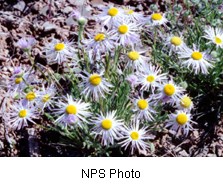
Erigeron pulcherrimus Family: Asteraceae (A Utah Flora - Compositae) - Sunflower Family Perennial herbs; stems 2” to 1.2' (5 to 35 centimeters) tall Leaves: basal and alternate; simple; basal leaves 0.32” to 2.8” (0.8 to 7 cm) long; 0.04” to 0.2” (1 to 5 mm) wide; leaves reduced upwards; has hairs Flowers: ray flowers and disk flowers; flower head appears to be a single flower, but is composed of several flowers (a composite). Flowers are white, pink, or violet; 25 to 60 rays; rays 0.32” to 0.6” (8 to 15 mm) long; flowers 0.08” to 0.148” (2 to 3.7 mm) wide Pollinators: other Erigeron species are pollinated by bees, moths and butterflies Fruits: achene – 1 seeded with hard shell Blooms in Arches National Park: April, May, June Habitat in Arches National Park: desert shrub and pinyon-juniper communities on saline and seleniferous clays, clay-silts, and gravel substrates Location seen: Delicate Arch road Other: The genus name, “Erigeron”, is from Greek “eri” meaning “early” and “geron” which means “old man” because the plant blooms early in the year and the seed's bristles resembles an old man's gray hair. The species name, “pulcherrimus”, means “beautiful”. This family is the most advanced and complex of the dicots. The family is rich in oils and resins and is found in every part of the world, but is infrequent in the tropical rainforest. Aquatic or semi-aquatic species are also uncommon. |
Last updated: March 11, 2022
